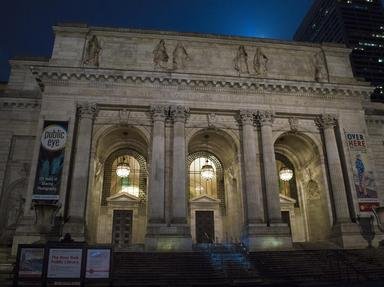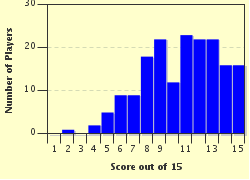Quiz Answer Key and Fun Facts
1. After being wounded in the Ambulance Corps while serving in the Italian campaigns during World War I, this American had plenty of experiences from which he could compose "A Farewell to Arms", published in 1929. Drawing upon his later experiences as a war correspondent reporting on the Spanish Civil War, he published "For Whom the Bell Tolls" in 1940. Who is this author who won the Nobel Prize for Literature in 1954?
2. This American poet attended Harvard for two years before he had to return home to Gardiner, Maine, to provide for his family. His father had died after the family lumber business failed, and his brothers were suffering from addiction. Observing the frustration of his family and others struggling around him, he found plenty of material for poems such as "Mr. Flood's Party", "Miniver Cheevy", and "Richard Cory". Who is this poet who lived in poverty until he was in his 50s and won the first of three Pulitzer Prizes for Poetry?
3. While a student at Yale, this American took some time off to work at the Helicon Home Colony, a somewhat socialist experimental commune created by Upton Sinclair. Its ideals influenced this writer's critical approach to American society's capitalistic and materialistic values in such novels as "Main Street", "Babbit", "Arrowsmith", "Elmer Gantry", and "Dodsworth". His works are also celebrated for his portrayal of strong female characters. Who is this author who became the first American to win the Nobel Prize for Literature, but refused to accept a Pulitzer Prize for Fiction?
4. While greatly associated with rural New England, this American poet was born in California, where he lived for eleven years, and published his first book of poems "A Boy's Will" in 1913 while living with his wife and children in England. Some of his very well-known poems focusing on the New England countryside are "Birches", "The Tuft of Flowers", "Death of a Hired Man", "Mending Wall", and "Stopping by Woods on a Snowy Evening". Who is this poet who won the Pulitzer Prize for Poetry amazingly on four different occasions and delivered a reading at John F. Kennedy's inauguration?
5. One of this writer's most celebrated works is "The Man Who Was Almost a Man", a short story about a seventeen-year-old African-American male in the rural South who has equated manhood with owning a gun and feels incomplete until he has one. The story suggests the young man has not achieved maturity because everyone around him perceives him as "nothing but a boy", long before he accidentally shoots his employer's mule and is subjected to public humiliation. Who is this Mississippi-born writer who became the first African-American author of a bestseller with the novel "Native Son"?
6. In 1922, a poem that forever altered the world's understanding of what poetry is was published. A generation of poets were forced to reckon with it, whether they were inspired by it and imitated it, or hated it and attempted to counter it. The poem's title and its view of modern civilization captured the destruction, loss, spiritual doubt, and gloom that were the aftermath of World War I. The poem consists of a jumble of fragmented images, dialogues, and allusions that portray the failures of government, Christianity, and human relationships. What is the title of this masterwork by the Nobel Prize-winning T. S. Eliot that begins with "April is the cruelest month . . . " and ends with "Shantih"?
7. As a young man, this eventual Nobel Prize-winning author failed college English, was fired from a post office job after opening others' mail and playing cards during work hours, and faked a leg injury to suggest that he had seen battle during World War I. Later he won a rare two Pulitzer Prizes for Fiction for "The Fable" and "The Reivers", awards many scholars believe were compensation for the neglect of his earlier artistically superior novels: "The Sound and the Fury", "As I Lay Dying", "Sanctuary", "Light in August", and "Absalom! Absalom!". Who is this writer who spent most of his life in Oxford, Mississippi?
8. As an American poet, she broke ground through her wrestling with the issue of how to be a female speaking in a world where women were spoken for and about by men. Her meditative epic "Helen in Egypt" is a feminist reinterpretation of the legend of Helen of Troy; it evolves from the historical presentation of Helen as a silent object and a question of whether Helen would even have a voice or point of view if allowed to speak. Who is this writer, once engaged to the poet Ezra Pound, who later helped Sigmund Freud escape from Nazi-controlled Austria?
9. During World War I, this writer was stationed in Montgomery, Alabama, where he fell in love with the Southern belle Zelda Sayre. She rejected his marriage proposal, so he went to New York City to make his fortune and win Sayre's heart. He succeeded by finishing in 1920 a novel he had started in college--"This Side of Paradise". His greatest novel, however, would arrive in 1925. What is the name of this book, often considered one of the top ten greatest American novels, that somewhat mirrors this writer's earlier life through the telling of a bootlegger who believes he has to acquire wealth to convince the woman he loves to marry him?
10. This individual was initially an accomplished abstract and modernist painter as well as a prose writer, publishing his autobiographical novel about his stay in a French prison camp during World War I--"The Enormous Room"--in 1922. However, it is for his reshaping of the realm of poetry that he is most remembered. What is the name of the poet who wrote "i sing of Olaf glad and big", "Buffalo Bill's", and "anyone lived in a pretty how town"?
11. "Long Day's Journey into Night" was published in 1956 and won the Pulitzer Prize for Drama in 1957. However, its author wrote the play in 1941, sealed it in a Random House vault, and left instructions that it not be published until twenty-five years after his death, apparently because of its autobiographical content concerning his dysfunctional family and their addictions. Who is this great American playwright who won the Nobel Prize for Literature in 1936?
12. A prominent figure and leader of the Harlem Renaissance, this American poet was often referred to as the "Bard of Harlem". He wrote novels, such as "Not Without Laughter"; short stories, such as those in his collection "The Ways of White Folks"; and plays, such as "Tambourines to Glory". However, he is celebrated mostly for his poetry. Who is this individual who helped develop jazz poetry with poems like "The Negro Speaks of Rivers", "The Weary Blues", and "Harlem" (often referred to as "A Dream Deferred")?
13. While a youth, this American author spent his summers working for Spreckels Sugar Company on sugar beet farms in California's Salinas Valley. He gained keen insight into the harsh lives of migrant workers and became acquainted with the cruel and cold tendencies of human beings. These experiences gave him the material and inspiration for many of his novels and novellas, such as "Of Mice and Men". Who is this winner of the Nobel Prize for Literature and author of the autobiographical "Travels with Charley" about his road trip around the United States with his poodle?
14. Many are familiar with poem XXII from the collection "Spring and All":
"so much depends
upon
a red wheel
barrow
glazed with rain
water
beside the white
chickens"
However, are you familiar with the poem's writer, who was awarded a posthumous Pulitzer Prize for his collection "Pictures from Brueghel and Other Poems" and who, as an old-fashioned family physician, maintained his practice through house calls and delivered over 2,000 babies?
15. This American modernist story revolves around two waiters in a cafe in Spain. The younger of the two waiters complains about how the two of them cannot close the cafe and go home because an old man refuses to finish his brandy. In fact, the young waiter says to him, "You should have killed yourself last week", referring to the old man's failed attempt at suicide. The story ends with the older waiter, after the cafe has finally closed, walking to a bar while reciting the Lord's Prayer and substituting the word "Nada" for various words ("Our nada who art in nada . . . "). What is this often-anthologized story by Ernest Hemingway?
Source: Author
alaspooryoric
This quiz was reviewed by FunTrivia editor
looney_tunes before going online.
Any errors found in FunTrivia content are routinely corrected through our feedback system.

